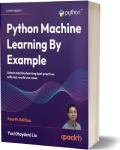Python Machine Learning By Example - Fourth Edition
Data Science
Book Details
Book Title
Python Machine Learning By Example - Fourth Edition
Author
Yuxi (Hayden) Liu
Publisher
Packt Publishing
Publication Date
2024
ISBN
9781835085622
Number of Pages
519
Language
English
Format
File Size
6.5MB
Subject
Data science
Table of Contents
- Cover
- Copyright
- Contributors
- Table of Contents
- Preface
- Chapter 1: Getting Started with Machine Learning and Python
- An introduction to machine learning
- Knowing the prerequisites
- Getting started with three types of machine learning
- Digging into the core of machine learning
- Data preprocessing and feature engineering
- Combining models
- Installing software and setting up
- Summary
- Exercises
- Chapter 2: Building a Movie Recommendation Engine with Naïve Bayes
- Getting started with classification
- Exploring Naïve Bayes
- Implementing Naïve Bayes
- Building a movie recommender with Naïve Bayes
- Evaluating classification performance
- Tuning models with cross-validation
- Summary
- Exercises
- References
- Chapter 3: Predicting Online Ad Click-Through with Tree-Based Algorithms
- A brief overview of ad click-through prediction
- Getting started with two types of data – numerical and categorical
- Exploring a decision tree from the root to the leaves
- Implementing a decision tree from scratch
- Implementing a decision tree with scikit-learn
- Predicting ad click-through with a decision tree
- Ensembling decision trees – random forests
- Ensembling decision trees – gradient-boosted trees
- Summary
- Exercises
- Chapter 4: Predicting Online Ad Click-Through with Logistic Regression
- Converting categorical features to numerical – one-hot encoding and ordinal encoding
- Classifying data with logistic regression
- Training a logistic regression model
- Training on large datasets with online learning
- Handling multiclass classification
- Implementing logistic regression using TensorFlow
- Summary
- Exercises
- Chapter 5: Predicting Stock Prices with Regression Algorithms
- What is regression?
- Mining stock price data
- Getting started with feature engineering
- Estimating with linear regression
- Estimating with decision tree regression
- Implementing a regression forest
- Evaluating regression performance
- Predicting stock prices with the three regression algorithms
- Summary
- Exercises
- Chapter 6: Predicting Stock Prices with Artificial Neural Networks
- Demystifying neural networks
- Building neural networks
- Picking the right activation functions
- Preventing overfitting in neural networks
- Predicting stock prices with neural networks
- Summary
- Exercises
- Chapter 7: Mining the 20 Newsgroups Dataset with Text Analysis Techniques
- How computers understand language – NLP
- Touring popular NLP libraries and picking up NLP basics
- Getting the newsgroups data
- Exploring the newsgroups data
- Thinking about features for text data
- Visualizing the newsgroups data with t-SNE
- Summary
- Exercises
- Chapter 8: Discovering Underlying Topics in the Newsgroups Dataset with Clustering and Topic Modeling
- Learning without guidance – unsupervised learning
- Getting started with k-means clustering
- Clustering newsgroups dataset
- Discovering underlying topics in newsgroups
- Summary
- Exercises
- Chapter 9: Recognizing Faces with Support Vector Machine
- Finding the separating boundary with SVM
- Classifying face images with SVM
- Estimating with support vector regression
- Summary
- Exercises
- Chapter 10: Machine Learning Best Practices
- Machine learning solution workflow
- Best practices in the data preparation stage
- Best practices in the training set generation stage
- Best practices in the model training, evaluation, and selection stage
- Best practices in the deployment and monitoring stage
- Summary
- Exercises
- Chapter 11: Categorizing Images of Clothing with Convolutional Neural Networks
- Getting started with CNN building blocks
- Architecting a CNN for classification
- Exploring the clothing image dataset
- Classifying clothing images with CNNs
- Boosting the CNN classifier with data augmentation
- Improving the clothing image classifier with data augmentation
- Advancing the CNN classifier with transfer learning
- Summary
- Exercises
- Chapter 12: Making Predictions with Sequences Using Recurrent Neural Networks
- Introducing sequential learning
- Learning the RNN architecture by example
- Training an RNN model
- Overcoming long-term dependencies with LSTM
- Analyzing movie review sentiment with RNNs
- Revisiting stock price forecasting with LSTM
- Writing your own War and Peace with RNNs
- Summary
- Exercises
- Chapter 13: Advancing Language Understanding and Generation with the Transformer Models
- Understanding self-attention
- Exploring the Transformer’s architecture
- Improving sentiment analysis with BERT and Transformers
- Generating text using GPT
- Summary
- Exercises
- Chapter 14: Building an Image Search Engine Using CLIP: a Multimodal Approach
- Introducing the CLIP model
- Getting started with the dataset
- Finding images with words
- Summary
- Exercises
- Chapter 15: Making Decisions in Complex Environments with Reinforcement Learning
- Setting up the working environment
- Introducing OpenAI Gym and Gymnasium
- Introducing reinforcement learning with examples
- Solving the FrozenLake environment with dynamic programming
- Performing Monte Carlo learning
- Solving the Blackjack problem with the Q-learning algorithm
- Summary
- Exercises
- Packt Page
- Other Books You May Enjoy
- Index
